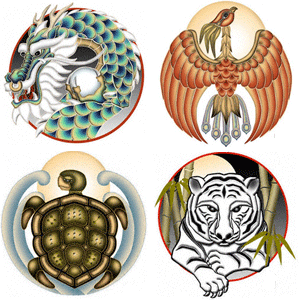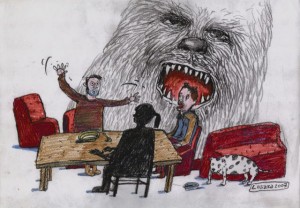Game Poem 36: Office
Welcome to Office! Office is a game for three or four players at the very least, but it will support arbitrarily large numbers, so feel free to play and experiment. To begin, pick one player – let’s say the oldest – to be the Manager. All other players will be Employees.
The Manager is in charge of setting up everything that is needed to play Office. They will need to find a whole bunch of coins or tokens, at least a dozen or so per player, and a bowl or some kind of container in which to hold them. The Manager will also need to assemble a stack of index cards or slips of paper, and several writing implements. The manager will also want to assign the role of Human Resources to one of the Employees, and put them in charge of distributing two tokens to each Employee. The manager begins with no tokens.
While HR is distributing the initial paychecks, the Manager should take a few moments to write down a bunch of initial assignments on the paper or index cards, at least one for each Employee to begin with. These are the tasks that the Employees will be performing in the course of their work day, and should be relatively simple, straightforward, and easy to verify. Each assignment should take a minute or less to complete, and take up mental space and processing power, but require no special or unusual skills. You will probably want to keep a variety of materials around to ensure the possibility for an interesting collection of tasks.
Here are some sample assignments to get you started, but feel free to make up your own:
- Write out multiplication tables for the numbers one through ten
- Write a list of animals, or male and female names, one for each letter of the alphabet
- Write a list of two or three dozen countries or U.S. States
- Write out the first thirty numbers of the fibonacci sequence, or the first thirty powers of two
- Put a shuffled deck of cards in order, Aces to Kings, Hearts to Spades
- Write out a sequence of times starting at noon, every eighteen minutes, to midnight
- Count the frequency of letters in all the Employees’ first and last names
- Draw a series of shapes according to your instructions
- Write out the words from a short paragraph in alphabetical order
- Drawn two dozen simple faces with different expressions
- Write out a list of two dozen movies that are currently playing
- Sort out a jar of coins into piles of pennies, nickels, dimes, and quarters
- Write out your full name twenty-five times
- Draw one hundred circles
- Make a list of your thirty favorite songs
- And so on…
Assignments must always be written down on an index card, not communicated to the Employees verbally. They may be discussed very briefly, but the assignment must be completed exactly as written, and must be written in such a way that they may be verified for correctness likewise.
Once the Manager has created the initial set of tasks, they will distribute them to their Team, one per Employee. When the last task is assigned, the Manager will start a timer for fifteen minutes or so. As soon as the timer starts, the day’s work has officially begun; when the timer goes off, the work day is done, and the game is over.
During the work day, the Employees may do a couple of things. They may work on their assignments, and when they are done, turn them in to the Manager. When a task is turned in, the Manager will give the Employee that completed the task one token, and also take one token for themselves. The task should also be verified for correctness; if it was completed properly, the Employee earns an extra token, and a bonus token will be awarded to either the Manager or the Employee, at the Manager’s discretion. Once they’ve collected their pay, the Manager will assign them a new task, and send them back to work.
An Employee may also decide to malinger and shirk off their assignment for a while, instead of working. To do this, they just need to go talk to another player for a bit about sports or television or politics or what they did over the weekend or their hobbies or anything that isn’t work. While they talk, the player that is being distracted may not work, but must count slowly to ten, and when they reach ten, they must give the slacker one of their tokens, and they can both go back to work. Or go forth and slack some more, somewhere else.
It is clearly in the Company’s interest to minimize goofing off, so the Manager or the Human Resources representative may interrupt someone who is distracting another player. If the malingerer is interrupted before their target counts to ten, they don’t take a token, and must go back to work without wasting any more of the Company’s time. Keep in mind that the Manager must also be continually coming up with and writing down new tasks for their Team, so they must split their focus between keeping an eye on the Employees while making sure that there’s always work to be done.
Employees may always feel free to complain to their Manager at any time if they think that the Manager is doing a bad job, rewarding them unfairly, giving them tasks that are too hard or too simple for their abilities, or ignoring the inappropriate behavior of the other Employees, or whatever comes to mind. There is no mechanical reward for this beyond the airing of the complaint itself.
Eventually, the timer will go off, and the work day will end. The Employees may turn in any tasks that they have just completed, but if the Manager says that it’s time to go home, then no more work may be turned in, and the game is over. Each player will count up their tokens, and the one who generated the most value for the Company wins! (If there is ever a tie, the Manager decides the winner.) This will very likely be the Manager, so you will also want to see which Employee has the most tokens – that player will be awarded the title Employee of the Month, and may play as Manager next time!





